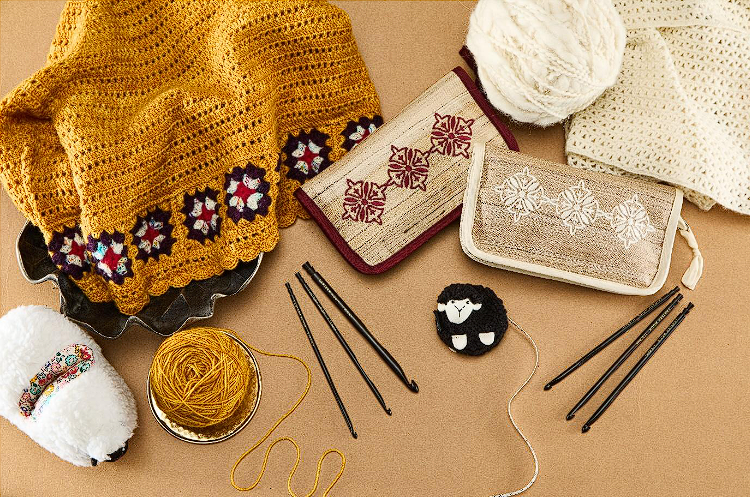
Have you started with a crochet project and realized halfway that the project is either too small or too large? Well, the reason is that you missed out on making a gauge swatch first. For the crocheter, a world of endless possibilities unfolds with each colorful skein of yarn. Once you learn the basic crochet stitches, you step into projects. While simple projects such as a scarf or a blanket require only your favorite crochet hooks and yarn, advanced projects require understanding gauge. If you are a crochet beginner, amid the excitement of choosing patterns and stitches, the gauge can sometimes feel overwhelming. However, understanding and getting the right gauge is essential. There are many reasons, but most importantly, it is to recreate the pattern and have the right fit. In this blog, we'll discuss everything you need to know about gauge in crochet and understand how it is essential for your crochet projects.
What is Gauge?
Gauge is the number of stitches and rows within a specific measurement (usually inches or centimeters) made with a particular yarn and crochet hook. It's like a map of your project journey. The small piece of crocheted fabric reflects your tension – how tightly or loosely you hold your yarn. Working on the gauge swatch lets you know if the hook or yarn is working according to your comfort level. You can also see a glimpse of the finished project. Plus, if a pattern mentions a gauge, it is essential that you have the same or similar count so that you achieve the same results as the pattern.
Let's take the example of two crocheters; let us assume they are Anna and Hannah. They follow the same pattern for a beautiful sweater. They work on a gauge swatch with the same yarn weight and single-ended crochet hook size, yet their finished sweaters come out in drastically different sizes. Why? The answer lies in gauge.
Why Does Gauge Matter?
A crochet pattern is written instructions for making a project to a specific size and shape. Matching your gauge to the pattern designer's gauge is essential to creating a fitting project, especially a garment or a perfectly sized accessory such as hats or socks. However, the project will be distorted if your gauge does not match the pattern's recommendation.
For example, getting a looser gauge, which means fewer stitches per inch, might result in a project, especially a garment such as a sweater or cardigan or even a hat or socks, that is too big and baggy. Similarly, a tighter gauge means more stitches per inch, which could yield a stiff, uncomfortable, and small project. Our previous blog on why gauge swatch is important will guide you through the first steps of planning your crochet project.
Why it is Important to Start Projects with Gauge Swatching

The humble gauge swatch is a small sample of fabric, typically a 4" x 4" square, crocheted using the same yarn, crochet hook size, and stitches (single crochet or double crochet stitch) as your project. Creating a gauge swatch is essential before diving into your main project. Even the most seasoned crocheters do not skip the step unless absolutely necessary.
3 Reasons that you cannot miss out on gauge
- Identify tension issues. If there's a difference between your gauge and the pattern's suggestion, then you can realize that either you have a tight or loose tension.
- It allows for adjustments if you need to get the exact stitch count mentioned in the pattern. You can adjust your crochet hook size if your gauge differs from the pattern. A smaller hook will create tighter stitches (fewer per inch) to compensate for a loose gauge and vice versa.
- Estimate yarn needs for the project when you are designing on your own. A well-made gauge swatch helps you estimate the amount of yarn required to complete your project. This avoids unpleasant surprises, such as running out of yarn midway through!
Crafting the Perfect Gauge Swatch: Step by step instruction
Step 1 - Use your chosen pattern's recommended yarn and crochet hook size.
Step 2 - Chain around 35-40 stitches or at least 4" to 6".
Step 3 - Crochet stitches as mentioned in the pattern. Single crochet is dense, while treble crochet is open; both will have different gauges, so follow the pattern.
Step 4 - Wash and block your gauge swatch as mentioned in the pattern or according to the yarn label.
Step 5 - Take a gauge measure. Mark an inch on the crocheted fabric and count the number of stitches horizontally and vertically.
Remember, mastering gauge takes practice and patience. Don't be discouraged if your first attempt isn't perfect. The beauty of crochet lies in its flexibility. Even if your gauge doesn't exactly match the pattern, you can still create beautiful and unique pieces.
Consider the purpose of the project. A slight variation in gauge might not be a problem for a scarf, blanket, or even home decor items. However, it's more important to strive for accuracy for a fitted hat, socks, or garments.
Don't be afraid to experiment! Gauge can be a tool for customizing projects to your personal style. For example, you could intentionally use a larger hook for a loose garment or a smaller hook for a more fitted look.
Explore the Lantern Moon Collection for your crochet projects and comfortable crafting experience. Choose smooth ebony wood crochet hooks with a luxury silk finish that is warm in the hands and prevents fatigue during long hours of crocheting. The Radiance Set of single-ended crochet hooks has 6 popular sizes that work for all projects. If you have the skills or requirements, you can explore Tunisian crochet with our interchangeable Tunisian crochet hooks or our handy Bequest Set that contains 6 interchangeable Tunisian hooks plus accessories to explore the Tunisian crochet craft.
